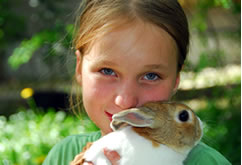A pet is an animal kept for companionship and enjoyment or a household animal, as opposed to livestock, laboratory animals, working animals or sport animals, which are kept for economic reasons. The most popular pets are noted for their loyal or playful characteristics, for their attractive appearance, or for their song. Pets also generally seem to provide their owners with non-trivial health benefits;[1] keeping pets has been shown to help relieve stress to those who like having animals around. There is now a medically-approved class of "therapy animals," mostly dogs, who are brought to visit confined humans. Walking a dog can provide both the owner and the dog with exercise, fresh air, and social interaction.
Terminology
Dogs and cats are often considered "small animals", while horses, cattle, sheep, and similar are considered "large animals". "Exotics" include birds, squirrels, and reptiles.[2]
Local restrictions
Many cities and towns have local ordinances limiting the number of pets a person may have, and may also restrict or forbid certain pets (such as fowl or exotics). Certain breeds of dog, such as pit bulls and rottweilers, are banned in some places. Dog/other canid/wolf mixes are also banned in some places.
The cities of Berkeley, California and Boulder, Colorado have passed laws stating that people who have pets do not "own" them; rather, they are the pet's "guardian."
Condominium associations and rental properties often ban animals[citation needed] because of the smells and noise the animals create.
Pet popularity
Around 63 percent of all U.S. households (71.1 million) are pet owners, and more than half of these households have more than one animal [3]. The two most popular pets in most Western countries have been cats and dogs. In the United States, a 2007-2008 survey shows that dog-owning households outnumber those owning cats, but that the number of pet cats is higher than dogs.[4] Combined reptiles are the next popular followed by birds followed by horses.
According to a 2007-2008 Pet Owners Survey[5]
| Animal | Number of U.S. households
that own a pet (millions) | Total number of pets owned
in the U.S. (millions) |
| Bird | 6.4 | 16.0 |
| Cat | 38.4 | 88.3 |
| Dog | 44.8 | 74.8 |
| Equine | 4.3 | 13.8 |
| Freshwater fish | 14.2 | 142.0 |
| Saltwater fish | 0.8 | 9.6 |
| Reptile | 4.8 | 13.4 |
| Small animal | 6.0 | 24.3 |
In Canada the latest survey done by Colin Siren of Ipsos Reid it is estimated that there are 7.9 million cats and 5.9 million dogs in Canada. The survey also shows that 35% of Canadian households have a dog, while 38% have a cat, which is consistent with other surveys conducted around the world. [6]
Overpopulation
Animal protection advocates call attention to pet overpopulation in the United States. According to the
Humane Society of the United States, 3-4 million dogs and cats are euthanized each year in the country and many more are confined to cages in shelters. This situation is created by nonneutered animals (
spayed/
castrated) reproducing and people intentionally breeding animals. A particularly problematic combination of economic hardship combined with a love of animals contributes to this problem in parts of the rural United States.
[7] In an average year, a fertile cat can produce three litters of kittens, with up to 4 to 6 kittens in each litter. Based on these numbers, one female cat and her offspring could produce up to 420,000 cats over a seven year period if not spayed or castrated. There are also major overpopulation problems with other pet species, such as birds and rabbits. Local humane societies,
SPCAs, and other animal protection organizations urge people to neuter their pets and to adopt animals from
animal shelters instead of purchasing them from breeders or
pet stores.
Effects on pets' health
Keeping animals as pets may become detrimental to their health if certain requirements are not kept. An important issue is the inappropriate feeding, which may produce clinical effects (like the consumption of chocolate by dogs[8]). Passive smoking is another recurring problem, aggravated by the fact that fur animals groom themselves, which means taking in extra harmful substances that have landed on their fur, not just those inhaled. A study has revealed that 44% of pet owners who smoke in UK do so around their pets, with 38% of them stating that they had no idea that second hand smoke could damage their pet's health.[9]
Effects of pets on their caregiver's health
Health benefits
Pets have the ability to stimulate their caregivers, in particular the elderly, giving people someone to take care of, someone to exercise with, and someone to help them heal from a physically or psychologically troubled past.[10] Having a pet may help people achieve health goals, such as lowered blood pressure, or mental goals, such as decreased stress.[11] There appears to be strong evidence that having a pet can help a person lead a longer, healthier life. In a study of 92 people hospitalized for coronary ailments, within a year 11 of the 29 without pets had died, compared to only 3 of the 52 who had pets.[10] A recent study concluded that owning a pet can reduce the risk of a heart attack by 2% and that pets are better than medication in reducing blood pressure.[citation needed] Dogs which are trained to be guide dogs can help people with visual impairments.
Pets in long-term care institutions
Even pet owners residing in a long-term care facility, such as a hospice or nursing home, experience health benefits from pets. Pets for nursing homes are chosen based on the size of the pet, the amount of care that the breed needs, and the population and size of the care institution.[10] Appropriate pets go through a screening process and, if it is a dog, additional training programs to become a therapy dog.[12]
Different pets require varying amounts of attention and care; for example, cats have lower maintenance requirements than dogs.[13]
Health risks
Health risks that are associated with pets include:
- Aggravation of allergies and asthma caused by dander and fur or feathers
- Injuries, maulings and sometimes deaths caused by pet bites and attacks
- Disease and/or parasites due to animal hygiene problems or lack of appropriate treatment (faeces and urine)
- Stress caused by behavior of animals
- Fear or distress from animal presence or behavior










